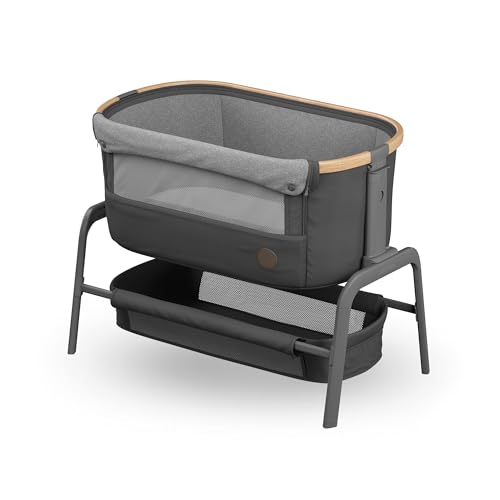The Ultimate Guide to Choosing a Bedside Cot for Your Baby's Room
As new parents prepare to welcome their youngsters, among the most pressing issues is developing a safe and comfortable sleeping environment. Bedside Cot For Sleeping Arrangements is a significantly popular option, supplying convenience and comfort. This short article explores the advantages of bedside cots, key features to consider, their advantages over conventional cots, and answers to regularly asked questions.
What is a Bedside Cot?
A bedside cot, also known as a co-sleeper or side-sleeper cot, is developed to attach safely to the side of the parent's bed. This ingenious sleeping service permits easy availability, enabling parents to tend to their baby's requirements without the requirement to leave their own sleeping space. This convenience fosters a bonding experience, as parents can easily reach their baby for feedings and comfort throughout the night.
Advantages of Using a Bedside Cot
Bedside cots provide various advantages that standard cribs might not offer. Here are some crucial benefits:
- Convenience: Bedside cots allow parents to be near to their baby without compromising space or security.
- Security: Many bedside cots satisfy safety standards and design features to make sure the baby can not roll out onto the floor.
- Breastfeeding Friendly: Mothers can easily breastfeed throughout the night without requiring to get out of bed.
- Easier Sleep Training: Bedside cots can make sleep training easier as babies feel secure being close to their parents.
Key Features to Consider When Choosing a Bedside Cot
When picking the best bedside cot for your baby's room, remember the following necessary functions:
1. Safety Standards
- Guarantee the cot satisfies local security regulations and requirements. Look for a cot that has breathable mesh sides for better ventilation.
2. Height Adjustment
- Try to find a cot with adjustable heights to match your bed's level, permitting a secure fit and lessening the threat of gaps.
3. Stability
- Make sure the cot has a sturdy frame to avoid tipping. Stability is essential for safety.
4. Portability
- If travel is expected, consider a lightweight model that can easily fold or dismantle.
5. Convertible Features
- Some cots can convert to a bassinet or playpen, permitting for extended usage beyond infancy.
6. Bed mattress Quality
- Look for a firm, correctly fitted bed mattress that meets security requirements to support the infant's delicate body.
7. Relieve of Assembly
- A cot that is easy to put together and disassemble can conserve time and aggravation, specifically for new parents.
8. Cost Range
- Budgets can differ; figure out in advance how much you are ready to invest in a bedside cot.
Comparisons: Bedside Cot vs. Traditional Cot
| Function | Bedside Cot | Traditional Cot |
|---|---|---|
| Ease of access | Easy access from bed | Needs full motion to reach baby |
| Co-sleeping Functionality | Designed for co-sleeping | Not appropriate for co-sleeping |
| Size | Generally smaller for space efficiency | Standard crib size |
| Mobility | Frequently more portable | Much heavier and less portable |
| Connection with Parent | Straight connected to the parent's bed | Freestanding, needing range |
| Adaptability | Can transform and adapt to numerous phases | Mainly for setting infant down |
Frequently Asked Questions (FAQs)
1. Bedside Cot For Sleeping Arrangements cots safe for newborns?
Yes, if appropriately set up according to security standards and connected firmly to the moms and dad's bed, bedside cots are safe for newborns.
2. Can a bedside cot prevent SIDS (Sudden Infant Death Syndrome)?
While no cot can ensure prevention of SIDS, using a bedside cot encourages safe sleep practices, enabling parents to monitor their baby closely.
3. The length of time can a baby use a bedside cot?
Typically, babies can use a bedside cot from birth approximately around six months old, depending upon the specific weight and height limitations set by the maker.
4. Do bedside cots feature a bed mattress?
Most bedside cots include a bed mattress; nevertheless, it's crucial to check that it adheres to security requirements and fits well within the cot to prevent spaces.
5. Can you use a bedside cot with a bed that has a high frame?
Yes, many bedside cots include adjustable heights to accommodate different bed heights. Always determine the bed height to make sure a correct fit.
6. What is the very best material for a bedside cot?
Try to find natural products such as strong wood or organic products that are totally free from harmful chemicals, making sure a safe environment for your baby.
A bedside cot can considerably boost the experience of new parents, supplying the availability and safety needed during the newborn phase. With careful consideration of the features outlined above, parents can select a bedside cot that finest fits their family's requirements. By investing in a quality bedside cot, parents can delight in more peaceful nights, knowing their baby is close by, secure, and comfortable.
Key Takeaways
- Bedside cots use benefit, safety, and convenience for both moms and dad and baby.
- Essential functions to consider consist of safety standards, stability, and size.
- Constantly ensure you choose a cot that fulfills security regulations and matches your way of life.
Developing a supporting environment for a baby doesn't end with the cot option but starts there, providing comfort and security for a peaceful night's sleep.

